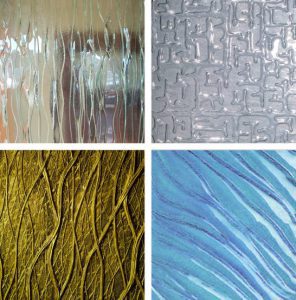Acid Etched Glass Panel Design Pattern OMC 103
$1.00
Description
History of Art Glass and Acid Etching
Acid etching on glass is a fascinating and versatile technique that has been used for centuries to create intricate and beautiful designs on glass surfaces. Acid etching involves the application of an acidic substance, such as hydrofluoric acid, to glass, resulting in the removal of a thin layer of the glass surface. This process creates a frosted or textured effect, allowing for the manipulation of light and the creation of stunning visual effects.

The history of acid etching on glass dates back to ancient times, with evidence of its use in ancient Egypt and Rome. However, it was during the late 19th and early 20th centuries that acid etching gained popularity as a decorative art form. Artisans and craftsmen recognized the unique qualities of acid etching, which allowed them to achieve detailed and delicate designs on glass that were not possible with other techniques. The process of acid etching begins with the preparation of the glass surface. The glass is thoroughly cleaned and dried to ensure the acid adheres evenly. The desired design is then transferred onto the glass using a variety of methods, such as stencils, hand-drawing, or the use of photoresist materials. The areas of the glass that are meant to be etched are covered with a protective layer, leaving only the design exposed.

Next, the acid is carefully applied to the exposed areas of the glass. The acid reacts with the silica in the glass, creating a chemical reaction that removes a thin layer of the surface. The length of time the acid is left on the glass determines the depth and intensity of the etching. The acid is then thoroughly rinsed off the glass, and the protective layer is removed, revealing the intricate etched design.
One of the remarkable aspects of acid etching on glass is the ability to create a range of effects. By controlling the etching process, artists can achieve different levels of transparency, allowing for the manipulation of light. This versatility makes acid etching ideal for various applications, including windows, doors, mirrors, and decorative glassware.

Acid Etched Glass for Various Interior Design Applications
Acid etching offers numerous benefits beyond its decorative appeal. It can provide privacy by creating frosted or textured areas that obscure the view while still allowing light to pass through. This makes acid etched glass a popular choice for bathroom windows, partitions, and doors. Additionally, acid etched glass can diffuse and soften harsh light, creating a pleasing and gentle ambiance in interior spaces.
In recent years, advancements in technology have expanded the possibilities of acid etching on glass. Laser etching techniques have emerged, allowing for precise and intricate designs that were once labor-intensive to achieve. This technology enables artists and designers to create highly detailed etchings, incorporating complex patterns, textures, and even three-dimensional effects.
Furthermore, acid etching is often combined with other glass treatments to create unique and captivating results. It can be combined with sandblasting, engraving, or even the application of color to enhance the visual impact of the etched design.

Whether used in architecture, interior design, or artistic expressions, acid etching on glass continues to be a highly regarded technique. Its ability to transform plain glass into a work of art, with its delicate and timeless beauty, makes it a popular choice among artists, designers, and architects alike. From classic and traditional designs to contemporary and innovative creations, acid etching on glass remains a versatile and captivating form of artistic expression.







